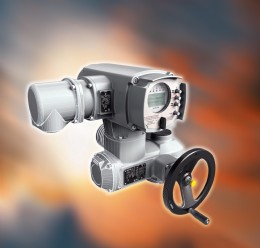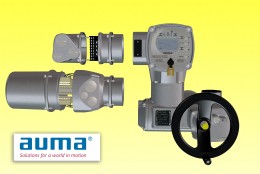Addressing Explosion Protection for Offshore Actuation

An impressive portfolio of offshore applications includes installations for Shell

AUMA’s Generation .2 actuator range includes explosion proof products

Plug-and-play modular AUMA technology benefits the offshore industry
First, a definition of what is meant by an explosion is provided and the importance of protection as an integral design feature of actuators is addressed:
As a precondition to trigger an explosion, a mix of flammable substances and oxygen is required. With a suitable ignition source, a chemical reaction results and, if the reaction velocity exceeds the sonic speed, this is defined as an explosion. The destructive effect of an explosion is the result of the sudden expansion of the build-up of flammable mixture in the form of a blast wave. An explosion hazard can safely be prevented if one of the three components (fuel, oxygen and an ignition source) is successfully eliminated.
Explosion proof equipment
Electrical equipment, including actuators, are a potential source of ignition as hot surfaces occur during operation and electric voltages/currents can cause ignition sparks. Explosion-proof electrical equipment, including actuators, must therefore be designed to prevent the occurrence of high temperatures at the surface and to ensure that there are no ignition sparks during operation.
Addressing this requirement, AUMA has developed a range of actuators for use in hazardous areas. Used in a wide range of applications including refineries, tank farms, extraction plants and pipelines around the globe, these actuators offer a robust and reliable solution for potentially explosive atmospheres.
The flameproof enclosure protection allows for an explosion inside the electrical equipment. Flameproof joints, or housing parts, are designed in such a way that burning particles or a flame cannot reach the outside elements: this is achieved by accurate sizing of the gaps and widths of the flameproof joints. Completing the explosion proof solution, a rigid housing ensures that the actuator can withstand, without damage, the pressure that develops during an internal explosion.
Certain oil industry applications require actuators to close the valve within a defined time span in the event of fire. Meeting this need, AUMA electric multiturn actuators in fireproof versions are available with a specially designed coating that ensures full functionality for at least 30 minutes if exposed to temperatures up to 1,100°C.
Adaptable actuation
Modularity plays a key role in the effectiveness of an explosion proof actuation solution. A mix and match system, with components dove-tailing, together ensures that the actuation products can be expanded, enhanced and refined on-site without removing the system for a factory upgrade. Housing electrical connections separately from the actuator using ‘plugand play’ technology is an important feature as wiring can be reached without disturbing the actuator’s internal components. And, from a safety perspective, should the actuator need to be removed, this can be done without contacting any cables.
Non-intrusive setting is another important feature of explosion protection actuation solutions – this is particularly important in hazardous areas, as the actuator housing does not need to be opened to change settings.
And, with regard to remote access to protect onsite operators, fieldbus technology has contributed significantly: using field device technology/device type manager (FDT/DTM), actuator parameters means actuators can be set remotely via the bus solution, which is of particular benefit in a hazardous environment.
Industry standards
Standards, as described in the European Standards EN 50014 etc. for electrical equipment and EN 13463-1 etc. for non-electrical equipment, have a key role to play in the development of actuation solutions and the selection of products.
Directives are also important: the ATEX Directive 94/9/EC for example governs European equipment supplied to potentially explosive atmospheres. It defines the general protection objectives: protection of persons and property. Precise knowledge of the conditions under which the devices are to be operated is important for the selection of the electrical equipment. The description is designated by one of the three following terms:
• Zone/equipment category
• Explosion group
• Temperature class
Potentially explosive areas are divided into zones according to the presence of possible explosive atmospheres. Gases are classified into explosion groups and temperature classes according to their hazardous level – the temperature class defines the permissible maximum surface temperature of the equipment and the explosion group divides the gases according to minimum ignition current and maximum experimental safety gaps.
Concluding this report, AUMA observes that the challenges of supporting oil depots and the requirements of supplying demanding offshore locations need to be clearly understood and addressed by any supplier of field devices. Issues of safety need careful attention, standards need to be monitored and solutions are required that enable upgrades with minimum disruption.
Note: AUMA has supplied electric actuators to the oil and gas industries for over thirty years. The company’s products are widely adopted internationally providing valve control for automation of refineries, tank farms, extraction plants and pipelines.
Auma Actuators Ltd
Tel: 01275 871141
Website: www.auma.com

| Telephone: | 01275 871141 |
| Email: | mail.uk@auma.co.uk |
| Website: | www.auma.co.uk |
| More information on the AUMA Actuators Ltd BVAA Member Directory Page |
Search related valve / actuator articles: AUMA Actuators LtdIssue 18Electric Actuators












